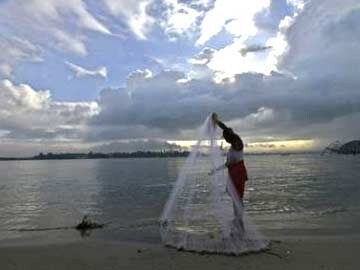
A fisherman arranges his fishing net at a beach against the backdrop of pre-monsoon clouds in of Kochi June 5, 2014.
New Delhi:
India's monsoon has covered half of its landmass four days behind the usual schedule, weather officials said on Thursday, as it has failed to recover from a late start this year on the southern coast.
The annual rains arrived over the Kerala coast five days behind the usual schedule of June 1 and then entered a lull, with poor rains over the interior parts of South India.
Rainfall was 45 percent below average for the week ended June 18, compared with 48 percent below average in the previous week, weather office data showed.
"Rainfall has increased in some parts of the central region, but the monsoon has continued to be weak," said a weather official did not wish to be named.
In the initial days of the June-September season, summer crops are not hugely influenced by the quantity of rain.
The distribution of rainfall in mid-July after the monsoon covers the entire landmass is more important for their growth.
India's farming sector accounts for around 14 percent of its nearly $2 trillion economy, and two-thirds of its 1.2 billion population live in rural areas.
So far, India's coastal areas on both sides and their adjoining areas have received rains.
With the arrival of Southwest monsoon, sowing activities of major summer crops such as rice, corn, soybean, cane and cotton have started in many areas but at a slower pace.
The annual rains arrived over the Kerala coast five days behind the usual schedule of June 1 and then entered a lull, with poor rains over the interior parts of South India.
Rainfall was 45 percent below average for the week ended June 18, compared with 48 percent below average in the previous week, weather office data showed.
"Rainfall has increased in some parts of the central region, but the monsoon has continued to be weak," said a weather official did not wish to be named.
In the initial days of the June-September season, summer crops are not hugely influenced by the quantity of rain.
The distribution of rainfall in mid-July after the monsoon covers the entire landmass is more important for their growth.
India's farming sector accounts for around 14 percent of its nearly $2 trillion economy, and two-thirds of its 1.2 billion population live in rural areas.
So far, India's coastal areas on both sides and their adjoining areas have received rains.
With the arrival of Southwest monsoon, sowing activities of major summer crops such as rice, corn, soybean, cane and cotton have started in many areas but at a slower pace.
© Thomson Reuters 2014
Track Latest News Live on NDTV.com and get news updates from India and around the world

